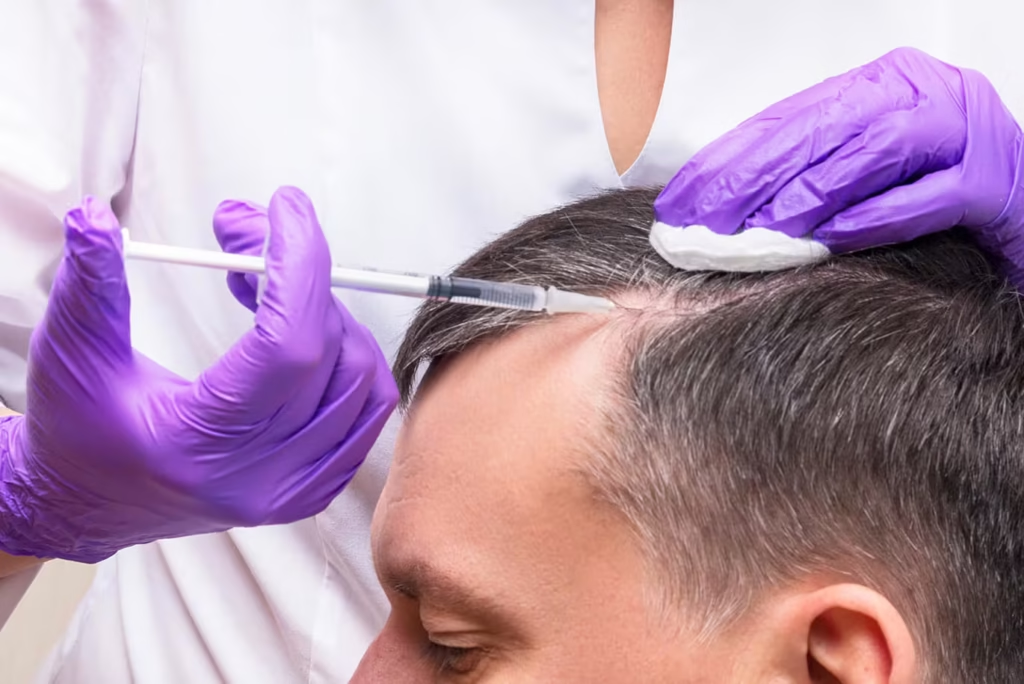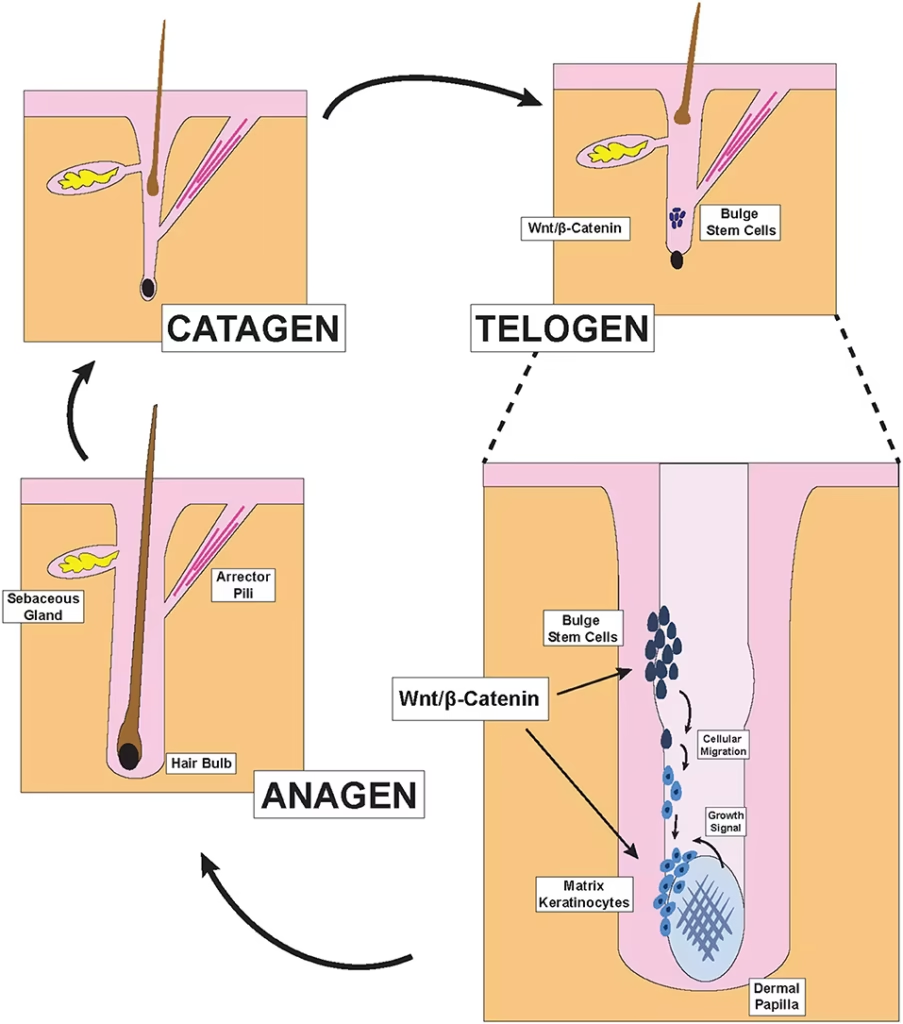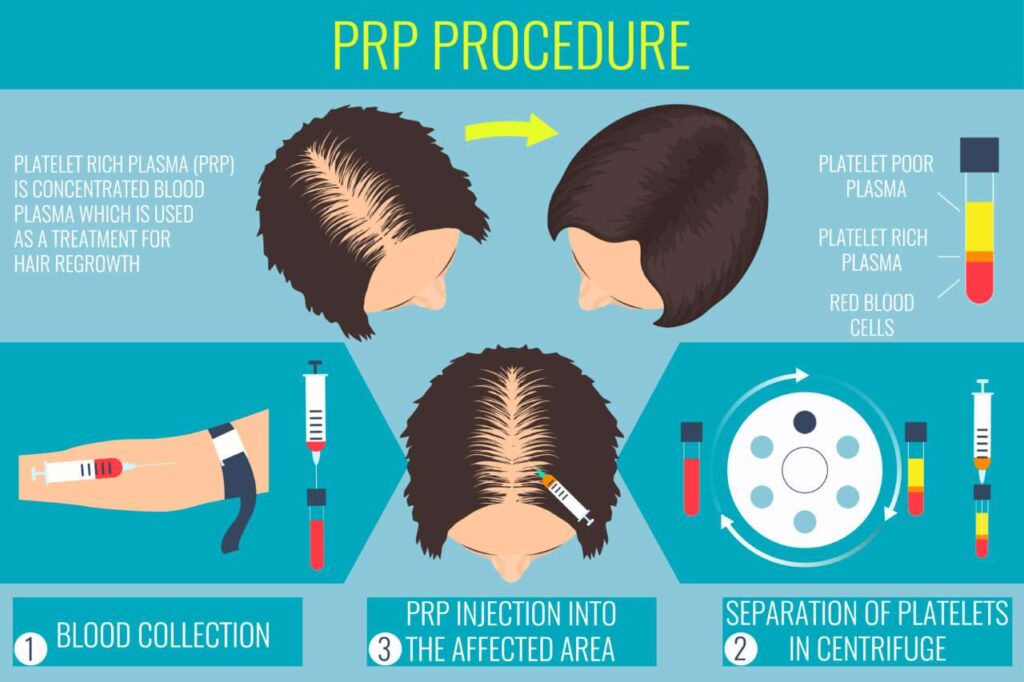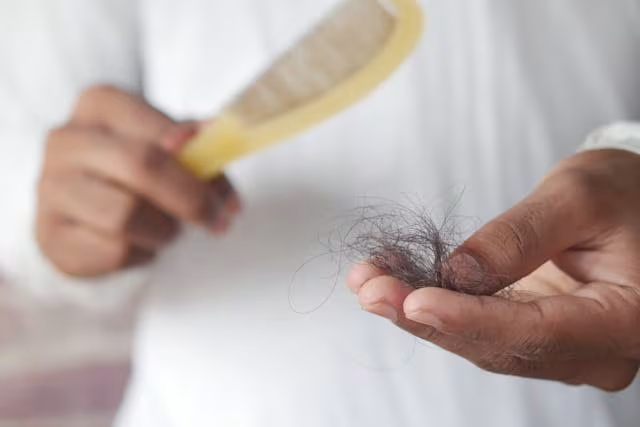What is PRP Treatment for Hair Loss?

Platelet-rich plasma (PRP) therapy is a regenerative medical treatment that uses the healing power of your own blood to combat hair loss.
The treatment begins with a small blood sample taken from your arm, which is then placed in a centrifuge.
This specialized machine separates the red blood cells from the plasma containing concentrated platelets.
The resulting PRP contains a high concentration of growth factors that, when injected into thinning areas of the scalp, stimulate hair follicles and strengthen existing hair.
These growth factors trigger a cascade of regenerative processes within the scalp, promoting tissue repair and encouraging new growth.
PRP therapy represents a significant advancement in hair restoration, offering patients a natural approach to combat hair thinning and loss without surgery.
The treatment utilizes your body’s own biological resources, making it an appealing option for those seeking non-invasive solutions.
Related article: Regenera Activa Singapore: Benefits, Risks, Costs
The Science Behind PRP Hair Treatment

PRP therapy works on a cellular level to revitalize hair follicles. When the concentrated platelets are injected into the scalp, they release cytokines and growth factors that:
- Stimulate angiogenesis (formation of new blood vessels)
- Enhance blood microcirculation in the scalp
- Activate stem cells present in hair follicles
- Promote cell proliferation and tissue regeneration
- Strengthen weakened hair follicles
The platelets in your blood are remarkable cells that naturally contain essential growth factors and proteins called cytokines.
These elements regulate immune responses and inflammation while playing a crucial role in your body’s natural healing processes.
In simplified terms, PRP causes a mass influx of growth factors such as platelet-derived growth factor and transforming growth factor.
These components exert their effects on fibroblasts, causing proliferation and vastly accelerating the regeneration of injured tissues.
Specifically, PRP enhances the fibroblastic events involved in tissue healing, including chemotaxis, cell proliferation, proteosynthesis, reparation, extracellular matrix deposition, and tissue remodeling.
You might like: Which Hair Transplant Clinic in Singapore Should You Consider? (Sort by Reviews)
The PRP Treatment Process

The PRP treatment process follows several carefully executed steps:
1. Preliminary Consultation
Your journey begins with a thorough assessment by a specialist who will analyze your hair situation, verify your medical history, and rule out possible contraindications.
This crucial consultation establishes a personalized treatment plan adapted to your specific needs.
2. Blood Collection
A small amount of blood (typically 20-60ml) is drawn from your arm, similar to a standard blood test.
This quick and minimally invasive procedure is performed under optimal hygiene conditions.
3. Centrifugation and PRP Preparation
Your blood sample is placed in a specialized medical centrifuge that separates the different blood components.
This process isolates the platelet-rich plasma from red blood cells and other elements.
The resulting PRP contains a platelet concentration 5 to 10 times higher than normal blood.
You might like: FUE Hair Transplant in Singapore: Cost, Reviews, Risks
4. Scalp Preparation and Treatment
A topical anesthetic may be applied to your scalp to ensure comfort during the procedure.
The concentrated PRP is then precisely injected into targeted areas of your scalp using very fine micro-needles.
These injections are strategically distributed to ensure optimal distribution of growth factors.
5. Post-Treatment Care
After the procedure, your hair will be washed, and you can typically return to your daily routine immediately.
There is no downtime required, and you can even drive yourself home after the treatment.
Read more: The Ultimate Guide to Hair Transplants in Singapore
Treatment Schedule and Maintenance
PRP hair treatment is typically performed in a series of sessions for optimal results:
- Initial treatment phase: 3 sessions at monthly intervals
- Maintenance phase: 2-3 treatments per year is recommended for ongoing benefits
The number of required sessions can vary based on your specific condition and how your body responds to the treatment.
Some patients experience noticeable improvement after the first session, while others may require multiple sessions.
For long-term maintenance, periodic sessions every 6-12 months are generally advised.
This approach helps preserve the benefits and maintain satisfactory hair density and quality much longer than without treatment.
Read more: Hair Loss Treatment in Singapore
Who is Suitable for PRP Hair Treatment?
Almost anyone experiencing hair loss can be a potential candidate for PRP treatment. However, certain factors influence the effectiveness of the therapy:
- Those with more recent hair loss tend to respond best to treatment
- Patients in early stages of hair thinning typically see better results
- It’s more challenging to reactivate hair follicles that have been dormant for a long time
- PRP works well for various types of hair loss, including androgenetic alopecia (male and female pattern baldness)
The most promising candidates are those in the early stages of hair loss (up to stage 3 on the Hamilton scale for men and stage 2 on the Ludwig scale for women).
You might like: Best Hair Loss Clinic in Singapore
Benefits of PRP Hair Treatment
PRP therapy offers several advantages over other hair loss treatments:
Natural Recovery
PRP utilizes your own blood, making it an autologous therapy that minimizes the risk of adverse reactions or infections.
Since the treatment uses components from your own body, the risk of rejection is extremely low.
Minimally Invasive
Unlike hair transplant surgery, PRP treatments are performed through simple injections, making the procedure much less invasive than surgical alternatives.
No Downtime
You can return to your normal activities immediately after treatment, with no significant recovery period required.
Safe and Well-Studied
PRP therapy has a long history of safe and effective use in various medical fields. It has been studied extensively and widely used in a diverse range of applications, with excellent safety profiles.
Complementary Treatment
PRP can be used as a standalone treatment or in conjunction with other hair loss solutions such as medications (Rogaine, Propecia) or before hair transplant procedures to strengthen the scalp and prepare hair follicles.
This might help: TCM for Hair Loss in Singapore
Side Effects and Risks
PRP comes from your own blood, so adverse reactions are rare. However, potential side effects may include:
- Temporary pain or discomfort at the injection site
- Mild scalp sensitivity for a few hours after treatment
- Slight swelling or redness that typically resolves quickly
- In very rare cases, infection at the injection site
- Potential for bruising at the blood draw site
Most patients describe only a slight feeling of pressure or tingling during the procedure, with minimal discomfort afterward.
Contraindications for PRP Treatment
Although PRP treatment is generally very safe, certain medical conditions constitute contraindications:
- Blood clotting disorders and low platelet counts
- Patients using anticoagulation therapy (warfarin, dabigatran, heparin)
- Active skin infections or sepsis
- Certain autoimmune diseases
- Chronic liver disease
- Active cancer or history of certain cancers
- Pregnancy and breastfeeding
- Uncontrolled diabetes may compromise treatment effectiveness
A complete medical assessment during your preliminary consultation will identify any potential risk factors and determine if PRP treatment is appropriate for your case.
PRP vs. Other Hair Loss Treatments
Regenera Activa vs. PRP
Both Regenera Activa and PRP are regenerative treatments, but they differ in several ways:
- Treatment protocol: Regenera Activa is a one-time treatment that lasts 1-3 years, whereas PRP requires multiple monthly sessions.
- Source material: Regenera Activa uses regenerative cells from your scalp, while PRP uses growth factors from your blood.
- Effectiveness: According to some sources, Regenera Activa is proven to be more effective, though both treatments have shown positive results.
PRP vs. Medications
PRP is not meant to replace FDA-approved therapies such as DHT blockers (Propecia) and Minoxidil (Rogaine).
Instead, these treatments often work best when used together as part of a multi-pronged approach to treating hair thinning and loss.
PRP as a Complementary Treatment
PRP is particularly beneficial as:
- A standalone treatment for early stages of hair loss
- A complement to medication-based treatments
- Pre-treatment before hair transplant surgery to strengthen the scalp and hair follicles
- Post-transplant therapy to enhance results and accelerate healing
Cost of PRP Treatment in Singapore
In Singapore, the cost of PRP therapy for hair loss varies based on several factors:
- The medical facility and its location
- The expertise of the healthcare provider
- The specific treatment protocol used
- The number of sessions required
On average, a single PRP session in Singapore ranges from a few hundred to a few thousand dollars. Many clinics offer package deals for multiple sessions, which can reduce the overall cost of treatment.
The History and Development of PRP Therapy
PRP has a rich history in medical applications:
- Scientists first identified platelets in the 1880s
- During the 1940s, researchers began experimenting with platelets for wound healing
- PRP was developed in the 1970s and first used in Italy in 1987 for open heart surgery
- Over the past few decades, PRP has expanded to numerous medical fields, including orthopedics, dentistry, sports medicine, and cosmetic applications
- In recent years, its application for hair loss treatment has gained significant popularity
FAQ Section
What are the main advantages of PRP over other hair loss treatments?
PRP offers several unique advantages: it’s completely natural as it uses your own blood components, there’s minimal risk of allergic reactions, it requires no downtime, and it can be effectively combined with other treatments.
Unlike medications, PRP doesn’t cause systemic side effects, and unlike transplants, it’s non-surgical.
The treatment strengthens existing hair follicles while potentially activating dormant ones, making it effective for both preventing further loss and enhancing growth.
How long do the effects of PRP treatment last?
The effects of PRP treatment are not permanent but can be maintained long-term with an appropriate maintenance protocol.
Initial results typically last for 12-18 months after completing the first treatment cycle. Since androgenetic alopecia is progressive, regular maintenance sessions every 6-12 months are necessary to preserve benefits.
Although PRP doesn’t permanently stop genetic hair loss, it significantly slows the process and maintains better hair density and quality much longer than without treatment.
Is PRP treatment painful?
Most patients report minimal discomfort during PRP treatment. The blood collection process feels similar to a standard blood test.
For the scalp injections, practitioners typically apply local anesthesia in the form of a numbing cream or cooling spray that significantly reduces sensation.
Patients usually describe feeling only slight pressure or tingling during the injections.
After treatment, temporary scalp sensitivity may persist for a few hours but typically resolves quickly without requiring pain medication.
How soon can I expect to see results from PRP treatment?
Results from PRP treatment aren’t immediate, as the therapy works by stimulating natural processes in the hair follicles.
Most patients begin noticing improvements after 2-3 months from the start of treatment. Initially, you might observe reduced hair shedding, followed by thickening of existing hair strands.
New hair growth typically becomes visible around 4-6 months into the treatment protocol.
The full results become more apparent after completing the initial series of 3-5 treatments, with continued improvement over time with maintenance sessions.
Can PRP be combined with other hair loss treatments?
Yes, PRP treatment works excellently as part of a comprehensive hair restoration approach.
For optimal results, many specialists recommend combining PRP with other treatments such as FDA-approved medications like Minoxidil (Rogaine) and Finasteride (Propecia).
PRP is also particularly effective when used before or after hair transplant procedures, as it can strengthen existing hair follicles and improve the success rate of transplanted hair.
Some patients also combine PRP with laser hair therapy for enhanced results.
What should I do before and after a PRP treatment session?
Before your PRP session, avoid blood-thinning medications and supplements (like aspirin, ibuprofen, vitamin E, or fish oil) for at least 3-5 days if medically permitted. Maintain good hydration and avoid alcohol for 24-48 hours before treatment.
After the session, do not wash your hair for at least 24 hours to allow the growth factors to properly absorb.
Avoid intense physical activity and direct sunlight on the scalp for 2-3 days. Refrain from using harsh hair products, heat styling tools, or hair dyes for about a week after treatment.
Is there any recovery time after PRP treatment?
One of the major advantages of PRP treatment is that there’s virtually no downtime required.
You can return to most normal activities immediately after the session. However, your scalp may feel slightly tender for 24-48 hours, similar to a mild sunburn.
Temporary swelling or redness might occur at injection sites but typically subsides within a day.
While you can resume work and daily activities right away, it’s recommended to avoid strenuous exercise, excessive heat exposure, and swimming for 2-3 days after treatment.
How is PRP different from stem cell therapy for hair loss?
While both PRP and stem cell therapy are regenerative treatments for hair loss, they differ in key ways. PRP uses concentrated platelets and growth factors from your own blood to stimulate existing hair follicles and create a favorable environment for hair growth.
Stem cell therapy, including treatments like Regenera Activa, utilizes actual regenerative cells typically harvested from your scalp or other tissue sources.
Stem cells have the potential to develop into new hair follicle cells, potentially creating new growth sites.
PRP is generally more accessible and has a longer track record, while stem cell therapy may offer more dramatic results in some cases but is typically more expensive.
Can PRP completely stop genetic hair loss (androgenetic alopecia)?
PRP cannot completely stop or cure genetic hair loss permanently. Androgenetic alopecia is a progressive condition influenced by genetics and hormones, particularly dihydrotestosterone (DHT).
While PRP significantly slows the progression of hair loss and improves the quality and density of existing hair, it doesn’t address the root hormonal causes like DHT-blocking medications can.
For most patients, PRP works best as part of a comprehensive approach that might include medications, proper hair care, and possibly other treatments. Regular maintenance sessions are necessary to sustain the benefits over time.
Who should avoid PRP treatment for hair loss?
PRP treatment isn’t suitable for everyone. Patients with blood disorders like thrombocytopenia, platelet dysfunction syndromes, or hypofibrinogenemia should avoid this treatment.
Those on anticoagulation therapy (blood thinners) may need medical clearance before proceeding. Individuals with active scalp infections, sepsis, or certain skin diseases should postpone treatment until these conditions resolve.
People with autoimmune conditions, uncontrolled diabetes, or active cancer typically aren’t good candidates. Pregnant or breastfeeding women should wait until after these periods to undergo PRP therapy.
Always discuss your complete medical history with your healthcare provider before starting treatment.
This comprehensive guide provides valuable information about PRP treatment for hair loss in Singapore.
If you’re considering this therapy, consult with a qualified healthcare provider to determine if it’s the right option for your specific situation and to develop a personalized treatment plan.

